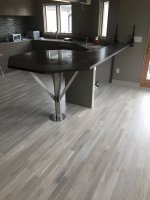Alex said:
Cheese said:
Alex said:
I do not need to polish it, designer wants the matte look, apparently that's totally the thing now over here.
Alex, what grit paper will you use for the matte finish?
I don't know, don't ask me such difficult questions! [smile]
It is the first time I'm working with this stuff. I didn"t even know you can sand it.
I asked my designer to ask his supplier and the answer he got back was that you can use any good construction glue to glue corian on other materials, he specifically mentioned the 4tecx glue I have. But you have to use the 2 part glue Tom mentioned if you want to glue 2 plates of corian together, and then you can sand it to make the connection seamless. Looks like I'll have to do both.
I'm going to explain an earlier statement I made. The reason you should not place solid surface matierial on a full top cabinet is they move very differently. Solid surface moves with changes in temperature, wood moves with changes in moisture. You don't want the products fighting with each other.
Never use an adhesive that hardens for the install, it must stay flexible, why I use Sil Bond. A veryslight gap to the wall is acceptable. The tops move.
A few pointers on using the two part adhesive;
Get extra mixing tips---at least six more, that should give you 8 tips. I buy them a box of 50 at a time.
Make sure you get the gun for the 2 part.
Place the tube in the gun, it will only go in one way.
Remove the caps from the tubes, do not install the mixing tube yet, hold the open end of the tube about 1" above scrap card board, squeeze the trigger until you get material to just expose.
Install the mixing tube, again over the cardboard squeeze the trigger until you get a dollop of adhesive on cardboard about 1" in diameter and 1/8" high. This gets the tube "primed".
You must do the above every time you need to apply adhesive.
Run a bead about 1/4" from the edges, run a squiggle between them.
Once done applying install the build up, next step, remove mixing tube, reinstall caps.
A few on doing the work;
MAKE A TEMPLATE
Make sure you glue on the back up blocks. Any other way is a lesson in frustration.
Clamp the build up where you want it, glue on the blocks with just a corner touching the build up.
Install one piece of build up at a time.
Practice with how you put the clamps on, you can move the build up around with the clamps when the adhesive is wet.
If there is a corner that needs build up, use a lap joint.
DO NOT wipe off any squeeze out, sand it off latter.
You'll need build up along the unseen sides. I use 15/16" strips of MRMDF (thickness assumes 2 pieces of build up stacked), you can use scrap solid surface.
I flush everything up using 2200's with special bits in them, then I sand.
Try to do any polishing before installing.
I'm sure I forgot something---good luck.
The one with the octagon weighed over 600 pounds. There is a staircase in a location where you can see the bottom of the top. It is kinda hollow, but appears solid. Forgot, the leg you see with the outlet/receptacle is hollow solid surface.
Tom




